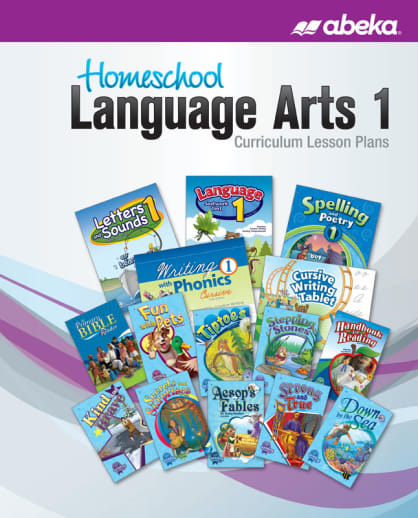Abeka's easy-to-use lesson plans for 1st grade language arts are very helpful. Covering Phonics/Language Arts, Reading, Poetry, Spelling, Handwriting, Creative Writing, and Writing Practice, these lesson plans are comprehensive, very clear in terms of teacher responsibilities and assignments, and user-friendly. Beginning with a subject-by-subject overview and grading information, the book continues with 170 daily lessons, each of which are spread over 1-2 pages. For each subject there are Preparation notes and Procedure notes; instructional lessons are interspersed with review. A stunning set of Appendices make up the remainder of the spiral-bound, 510 pages. There are Seatwork Teaching Notes, Songs & Games, plus numerous phonics resources – Blend Ladders, Blend Ladder Vowel Chart, Blend Ladder Letter Cards, and Phonics Words List. Writing Resources (suggested writing comments, cursive and manuscript formation guides, and sample handwriting tests) and Planning Resources (scope & sequences, integration of creative writing across subject matter, advanced and reduced reading pacing options, and planning calendars. Altogether, an amazing all-in-one curriculum resource.
Abeka Language Arts 1 Homeschool Curriculum Lesson Plans (5th Edition)
Description
Let us make it easy so that you can make it amazing! Abeka has abbreviated your preparation time with a detailed lesson guide for each Language Arts 1 subject based on more than a half century of educational experience. All the subjects for one day are conveniently located together. Each of the 170 days of lesson plans is divided by subject. Included are daily prompts for which content to review and teach, visuals to display, and what to write on the chalkboard. To help you teach the fundamentals of phonics, this guide includes tips for teaching, phonics word lists and blend ladders, enrichment activities, progress reports, and scheduling helps. Examples are provided throughout to make the instructions clear. Complete with lesson plans for phonics, reading, cursive handwriting, spelling and poetry, and seatwork, these lesson plans helps you stay organized and prepared as you guide your first grader to the optimal learning experience.
?
To use this program purely as a Grade 1 phonics/reading program you will need:
- Language Arts 1 Curriculum/Lessons Plans
- Letters and Sounds 1 (bound/unbound; student, teacher)
- Letters and Sounds 1 Tests (both student and answer key)
- Reading Handbook
Add the Reading Program (9 Readers plus Reading 1 Answer Key, Writing with Phonics 1 (cursive or manuscript), Writing Tablet, Language 1 Seatwork (bound or unbound student; teacher), and Spelling & Poetry 1 to round out a Language Arts program.
| Product Format: | Paperback |
|---|---|
| Grade: | 1 |
| Brand: | Abeka |
| ISBN: | 9780000294807 |
| Length in Inches: | 11 |
| Width in Inches: | 10.25 |
| Height in Inches: | 2 |
| Weight in Pounds: | 3.5 |

